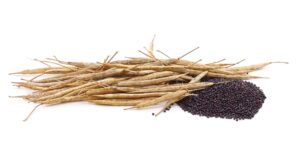Saskatchewan Bulletin
SaskCanola research results
New nutrient uptake and removal guidelines
Producers in Western Canada now have access to current micronutrient and macronutrient data for 14 annual crops grown on the Prairies.
Funding:
Saskatchewan Canola Development Commission, Alberta Wheat Commission, Prairie Oat Growers Association, Saskatchewan Flax Development Commission, Saskatchewan Wheat Development Commission and Western Grains Research Foundation.
Researchers:
Fran Walley, Richard Farrell and Gazali Issah, University of Saskatchewan; John Heard, Manitoba Agriculture; and Lyle Cowell, Nutrien Ag Solutions.
 Published in March 2023, the report provides growers and agronomists with current crop nutrient uptake and removal data to assist in their crop and fertilizer management planning. Prior to this study, the Canadian Fertilizer Institute (CFI) nutrient removal guideline published in 2001 was an important resource for growers, however, management practices and new varieties pointed to a need for updated information.
Published in March 2023, the report provides growers and agronomists with current crop nutrient uptake and removal data to assist in their crop and fertilizer management planning. Prior to this study, the Canadian Fertilizer Institute (CFI) nutrient removal guideline published in 2001 was an important resource for growers, however, management practices and new varieties pointed to a need for updated information.
Based on measurements taken from straw and seed samples, the study analyzed both nutrient uptake (the amount of nutrients taken into the plant to produce seed yields) and nutrient removal (the amount of nutrients removed from the field when the crop is harvested.) These areas are integral to 4R fertilizer management practices – right source, right rate, right time, and right place – in terms of nutrient management practices, according to the report, and should be used in conjunction with soil testing.
Conducted from 2020 to 2022, data collection for the study took place across Manitoba, Saskatchewan and Alberta and included barley, corn, durum, oats, spring wheat, winter wheat, canola, flax, soybeans, mustard, chickpeas, dry beans, lentils and field peas. Due to an increase in seeded acres and sample availability, faba beans were added to the study.
More than 2,200 grain and biomass samples were analyzed for macronutrients nitrogen, phosphorus, potassium and sulphur, and micronutrients copper, boron and zinc. A Prairie-wide drought limited the collection of biomasses in 2021, but presented researchers with an opportunity to assess how drought affected nutrient uptake and removal.
A comparison of grain samples collected over the three years determined that while drought has an impact on crop yield, the removal and uptake remained relatively unaffected.
The full report includes data for average grain yields and nutrient removal in terms of pounds per bushel of grain, as well as variability data which was previously only available in a range format.
“The variability in nutrient uptake was interesting,” says Richard Farrell, associate professor, Department of Soil Science, University of Saskatchewan, who was a researcher on the project. “This is important data for producers who want to dig a little deeper and see what additional information they can gain.”
Crop varieties, soil fertility and general growing conditions may affect both nutrient uptake and removal, according to the report.
In addition to the table data available, the Prairie Nutrient Removal Calculator was developed as an added resource for producers. The interactive calculator allows growers to input crop type and bushels per acre and receive a breakdown of nutrient data for both the micro- and macronutrients. The calculator is aimed at reducing the risk of underestimating nutrient removal levels and provides an estimated value based on the 75th percentile of survey data.
Amalgamation survey feedback
Reminder: Farmers invited to provide input to SaskCanola and
SaskFlax through online survey
Since January, SaskCanola has been providing operational services to the SaskFlax board. Resolutions were passed at both Commissions’ Annual General Meetings (AGMs) calling for the two organizations to explore options for potential amalgamation.
A general theme among the concerns raised so far is that “flax could get lost in the mix,” but on a similar wavelength, other growers suggested “flax issues would be a distraction for canola.” Both SaskCanola and SaskFlax boards feel these shared sentiments can be alleviated with proper governance mechanisms put in place at the onset of the merger.
The next step toward full amalgamation is to gather feedback from canola and flax growers. All Saskatchewan canola and flax growers were sent a notice in the mail in July encouraging them to participate in an online consultation survey (use QR code or visit saskcanola.com); which will remain open to gather input until November 17, 2023.
Based on feedback received to date, an overwhelming majority of respondents support the amalgamation. A general theme among the concerns raised so far is that “flax could get lost in the mix,” but on a similar wavelength, other growers suggested “flax issues would be a distraction for canola.” Both SaskCanola and SaskFlax boards feel these shared sentiments can be alleviated with proper governance mechanisms put in place at the onset of the merger.
A consultation document providing background, rationale and process surrounding the potential amalgamation of SaskCanola and SaskFlax has been prepared for farmers to review in conjunction with providing their feedback through the online survey.
Final survey results will be shared and official voting on the proposed amalgamation will take place during both Commissions’ AGMs on January 9, 2024 at the Western Development Museum in Saskatoon. Visit saskcrops.com/agms for registration info.
Both Commissions are producer-led organizations and have similar mandates directed by the Agri-Food Act. SaskCanola is supported by 17,000 levy-paying Saskatchewan canola producers. SaskFlax is supported by 3,000 levy-paying Saskatchewan flax producers.
Survey results will be shared and official voting on the proposed amalgamation will take place during both commissions’ AGMs on January 9, 2024 at the Western Development Museum in Saskatoon. Visit saskcrops.com/agms for registration info.
SaskCanola invests in next generation of researchers
Every year, SaskCanola awards two, two-year scholarships to students enrolled in graduate programs with canola-related projects. In doing so, our goal is to build research capacity by investing in the future of the canola industry. Congratulations to this year’s deserving recipients Nirpesh Dhakal (Chemical Engineering) and Hansanee Fernando (Plant Science)!
Nirpesh is focused on adding value to canola meal by extraction of nutrients in the form of amino acids, vitamins and minerals. These could be used as a “canola meal extract” in microbial media in industrial fermentations.
Hansanee is developing a systematic yield prediction model by using remote sensing technology to identify factors that drive canola yield, including mapping the long-term stability of canola yield across fields.
Two graduate students – Berenice Romero (Entomology) and Mostafa Hojati (Soil Science) – who received the scholarships in 2022, will also be continuing their studies at the University of Saskatchewan.









